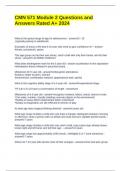CMN 571 Module 2 Questions and
Answers Rated A+ 2024
What is the typical range of age for adolescence - answer10 - 19
(typically puberty to adulthood)
Examples of areas of life that 5-10 year olds need to gain confidence in? - answer
friends, schoolwork, sports
This age group can tie their own shoes, catch a ball with only their hands, and tie their
shoes - answer5-10 Middle Childhood
What does kindergarten mark for the 5 year old - answer acceleration in the separation-
individuation theme initiated in preschool years.
Milestones for 5 year old - answerKindergarten attendance.
Ready to relate to peers- interact
Sensorimotor coordination matured, (paper/pencil task, sports)
What is the cognitive ability stage of a 5 year old - answerPreoperational stage
T/F Can a 5-1/2 have a conversation of length - answeryes
Milestones of a 6 year old - answer*recognize numbers, letters, words, learns to write
*Can order, number, classify (relating concrete objects in the environment)
*Reality of cause-effect relationships better understood
*fantasy & imagination are still reflected in themes of play
At what age does magical thinking diminish - answer6 years old
What age range includes a child who can draw a triangle, distinguish between morning
or afternoon, draw a person with 12 details and read several 1 syllable printed words. -
answer6-7 years
What age range includes a child who can catch a ball, copy a plus sign already drawn,
knows right and left hand, and tell their age . - answer5-6 years
What age range has approximately 2260 words , intelligible 6 or 7 word sentences -
answer6-7 years
Where do 7-10 year olds devote most of their energies - answerschool and peer group
,What are the major developmental tasks of a 7 year old - answerachievement in school
acceptance by peers
At what age do academic expectations start to intensify, become MORE ABSTRACT,
require child to concentrate on, attend to, and process increasingly complex
auditory/visual info? - answer7 year old
What level language does a 7 year old have - answerAdult proficiency
What age range can a child count by 2s and 5s, subtract by 1 digit numbers, tie shoes,
copy a diamond, knows what day of the week it is but not date or year, and draw a man
with 16 details - answer7 year old.
What age does a child master conservation of volume - answer8
What are some consequences of learning disabilities or attention, organization, and
impulsivity problems - answerthey may receive negative reinforcements from
teachers/parents- poor self-image manifested by behavioral difficulties.
* pediatrician must evaluate for potential learning disabilities in any child not developing
adequately at this stage or present w/emotional/behavioral issues
What makes the developmental status of a school-aged child more difficult to document
- answerthe complexity of milestones
*quality of response, attentional abilities, child's emotional approach to the task can
make a dramatic difference in success at school.
* the clinician must consider all these aspects in the differential diagnosis of learning
disabilities and behavioral disorders.
What age group can define words better than by use (What is an orange - "a fruit")
Can answer appropriately to "what is the thing for you to do if
-youve broken something that belongs to someone else?"
-a playmate hits you without meaning to do so?" - answer8-9 year old
What age group knows the month, day, year, months in order (in 15 seconds with 1
error) and makes a sentences with these 3 words in it (work, money, men, OR boy,
river, ball.) - answer9-10 year old
When a 9-10 year old reads and comprehends this passage
" Six boys put up a tent by the side of a river. They took things to eat with them. When
the sun went down, they went into the tent to sleep. In the night, a cow came and began
to eat grass around the tent. The boys were afraid, They thought it was a bear."
What question should the child be able to answer. - answerWhat was the cow doing?
, Which disorder is defined as repeated urination into clothing during the day and into the
bed at night by the child who is chronologically and developmentally older than 5 years
old?
How often must this occur before diagnosis? - answerEnuresis
Twice a week for 3 months
What type of disorder is monosymptomatic enuresis - answerMaturational (delay in the
maturation of the urologic and neurologic systems) with no underlying organic problem
At what age are children usually continent at night - answerwithin 2 years of achieving
daytime control.
What are some causes monosymptomatic enuresis - answerGenetic
Higher threshold for for arousal (not waking for full bladder sensation)
Overproduction of urine r/t decreased production of desmopressin or resistance to ADH
What lab work should be obtained if a child is experiencing enuresis - answerEvery
child- u/a including specific gravity
*add culture in girls.
What is the treatment for monosymptomatic enuresis - answerBehavioral strategies x 3
months every night (limit liquids before bed, wake child at night, bedwetting alarms)
educate guardian r/t judgement/shame toward child
*parents need to be active participants
What medication can be used if behavioral strategies fail when treating
monosymptomatic enuresis? - answerDesmopressin acetate (DDAVP)- decreases urine
production but if meds stopped high relapse rate
Age of daytime continence achievement of child - answer70% by age 3
90% age 6
What does complicated/non-monosymptomatic enuresis suggest? - answerunderlying
disorder.
What history does the FNP need to ask for if patient is experiencing non-
monosymptmatic enuresis? - answerMedical history, physical exam, and Diary of daily
records of voiding and fecal elimination
What age range most often experiences encopresis - answer5-6 year olds
What disorder is defined as repeated passage of stool into inappropriate places
(underpants) by child who is chronologically or developmentally older than 4 years old
How often must this occur before diagnosis? - answerEncopresis
Each month for at least 3 months and is not attributable to the physiologic effects of
substances or medical condition except to mechanism causing constipation




